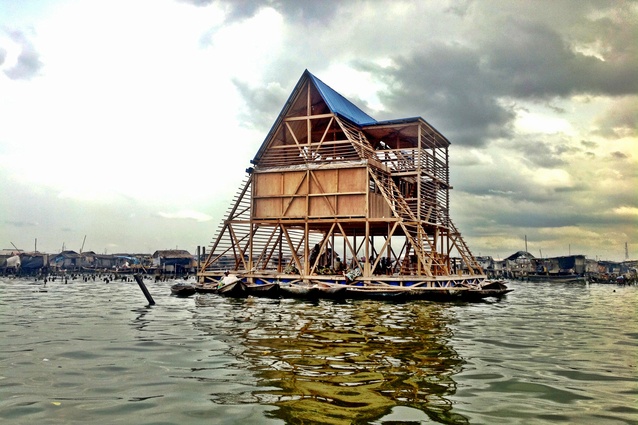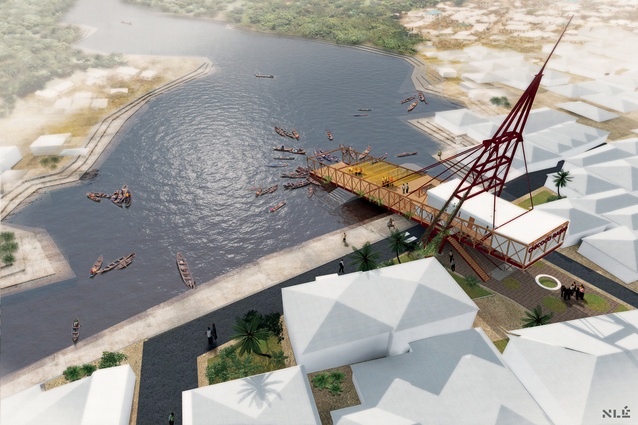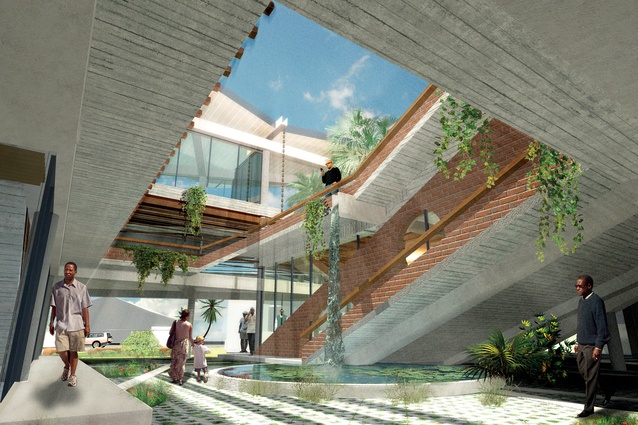Q & A: Kunlé Adeyemi
The 2015 NZIA conference in:situ in February brought together a stellar line-up of international architects and academics who shared their projects and experiences of working in the architectural profession in different parts of the world. Born in Nigeria but working from Amsterdam, Kunlé Adeyemi of NLÉ Works has landed himself in the media spotlight with his design for a floating school in an impoverished area of Lagos, which inspires alternatives to the invasive culture of land reclamation. He spoke with Justine Harvey of Architecture New Zealand during the conference.
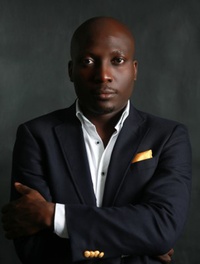
Justine Harvey: You studied architecture at the University of Lagos, worked in Nigeria, then studied at Princeton University in the USA and you’ve worked for Rem Koolhaas at OMA in The Netherlands; how does that ‘diverse’ experience influence you as an architect?
Kunlé Adeyemi: I moved out of home when I was 12 to attend boarding school in Lagos and, from there, I travelled to my dad (also an architect) all over the country, so travel was always part of my childhood. It’s a way of life and something I really desire because I’m inspired by different environments.
JH: So you’re not afraid of being challenged?
KA: Not at all. One of the main reasons I decided to move on from OMA was that I needed a new challenge. I used to go back home to Nigeria and see opportunities and challenges. I wanted a new kind of environment. I had practised architecture in the Western world and gained experience and thought this could be of service to places in Africa.
JH: NLÉ Works is four years old but you’ve made considerable headway in that time, haven’t you?
KA: The profession takes a long time to mature, as you know, and I’ve been fortunate to have the (Makoko) Floating School, which has received a lot of attention. It is one of the smallest projects I’ve worked on in the last 10 years but it’s one of the most challenging, not technically, but to my way of thinking. It expanded my mind in a totally different way.
JH: Did you approach the government to start the project?
KA: Yes. It was 2010, the time the new government came to the second term of administration, and I just literally offered my services and asked, “How can I be part of this helping Lagos? What are the challenges?” And they said housing would be great for you to look at for us. It’s quite ironic because the school actually started out with this interest to solve the housing problem.
JH: And you built your prototype. How was it funded?
KA: Yes. From the United Nations Development Programme.
JH: Is there any way you can build more?
KA: Well, not until they give (Makoko) consent but I will have discussions (with them) around policy… to start to think about building on water and to have us involved in that process.
JH: The slum clearance in Lagos was documented on the Rebel Architecture TV programme in which you were featured. It’s a really serious challenge for an architect; on the one hand, you’d want to work with the state and, on the other hand, there are decisions being made that go against an architect’s principles, in a way. How do you negotiate that in Nigeria where there are huge political issues?
KA: Exactly but with every society there’s a learning curve and the Nigerian leadership, also, is going through that learning curve of what kind of development trends they should apply. In their view, they come from a generation where slums are just there. Slum clearance is the approach to dealing with settlements, rather than finding other ways of regenerating more organically. It’s only now that we’re showing examples: “Look at the case studies. Look at other parts of the world which are taking different approaches. We don’t just displace people.” I think it’s a change of attitude.
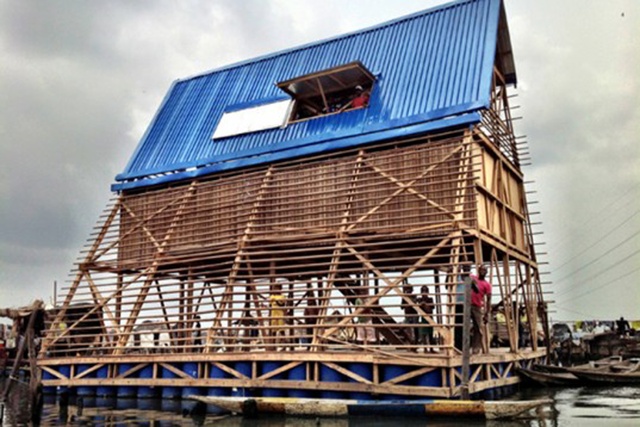
What I’ve done with the community there is about being proactive, ‘showing’ by example, as opposed to thinking, and saying, “This is there – look at it, test it, see if you like it.” It’s not a paper project any more. It’s far from perfect but it’s something they can evaluate. Since completion, the state has been assessing it, and has written and submitted its reports saying that “this building is stable and a viable model for replication” but it just hasn’t put that into action yet.
JH: Some architects might have gone into Makoko, looked at what’s existing, the houses on stilts, and tried to replicate those forms. But you’ve taken it a step further in thinking about rising sea levels and created a new typology.
KA: For me, it’s another example of how architecture is a way of thinking, of addressing different problems. The first thing is identifying those issues and then reconstituting the solutions into something different. It’s composition. Architecture is like music. You find tunes, you find the beats and you produce something completely different in great layers. People might use the same tunes and beats but it doesn’t sound the same. So it’s about practice and it’s about training.
JH: It would be very exciting to build more of this form as housing.
KA: Absolutely and we’re still a long way from perfecting it in that sense but, as it stands, it works, so we can have variations of what are preference-like examples.
JH: Has your Chicoco Radio project started on site?
KA: No, we’re starting construction shortly. We’re tendering and it’s my next big challenge because it’s a much more technically complex project than the school was. It’s about three or four times bigger and it’s not a straightforward construction.
JH: Is it being built locally?
KA: Yes. It’s important that the architecture can be produced locally, and that local materials are then injected, as much as possible, with whatever relevant global technologies or materials are needed to take it to the next level. It is being funded by different NGOs.
JH: Nigeria has this great diaspora but several of my Nigerian friends have given up on their country because they’ve seen a lot of good people doing good work with little or no effect. You look at Fela Kuti, who was a political force as well as a musician, and look at the troubles he had. It must be an awful thing to give up hope, I think.
KA: Definitely. You get that and I’m sure people have been through a lot worse. You come up with best intentions and then it gets caught up in politics but it’s not a reason to give up. For me, you need to understand and be careful how you deal with the system. I’m not oppositional, I’m just propositional. It’s about a win:win. That’s the important thing and I try to ensure that situation. It’s not about aggression, it’s just about progression.
JH: I’m interested in this idea of instigation. How, with the problems around the systems and processes of architecture, can we still ensure the most interesting architecture happens outside of that? You’ve created projects outside of the conventional process of procurement, as it were; Sarosh Mulla and other conference speakers like Andrew Maynard have done so too.
KA: I don’t know what gaps are available to be filled in that active space (in New Zealand). I don’t advocate anything illegal but it’s really about finding gaps in the system that can be filled in a constructive way. Take Makoko School, for instance; when there were questions about it being illegal and they said, “Well, you didn’t get planning approval,” I asked, “Do you get planning approval for a boat?” It’s not a building, right, so essentially there was a gap in the system where it’s not quite a building and it’s not quite a boat.
It’s somewhere in between and there is no policy for floating housing in Nigeria so it’s only now that they would start to write something (regulations). For a building, you need a land title but we’re not talking about that. Makoko’s movable; it’s a water craft so you need, maybe, a permit or a mooring licence… This building is possibly going to be the first approved typology to receive approval.
Basically, it’s about understanding these gaps and trying to address those issues, so there are still opportunities in a place like New Zealand to find positive construction interventions that address real problems in provocative ways: that actually fill gaps that are existing. To find that out in housing, you will look at the housing system, at the housing policy, or maybe in the public sphere and regulation… If you really look at the problem, I’m sure you will find the solution.

